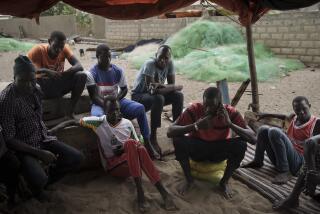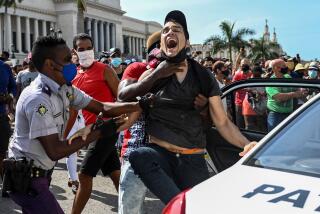High Seas Turn Back Cuban Exiles’ Flotilla
- Share via
ABOARD THE CUBAN SUBMARINE HUNTER CS-321 — One week after Cuban jet fighters downed two small civilian planes, an armada of U.S. Coast Guard ships escorted a flotilla of Cuban Americans back into the Straits of Florida on Saturday for a storm-tossed memorial service for the four exiles who died in the shoot-down.
Thirty private boats left Key West, Fla., just after sunrise, but by early afternoon heavy rains, high winds and waves of up to 10 feet forced some to turn back and ultimately scuttled the exiles’ plans to reach the exact spot where the two Cessnas had been destroyed.
Those aboard 13 vessels that ventured the farthest into the roiling Gulf Stream dropped flowers and wreaths into the water about 40 miles south of Key West, sang the Cuban national anthem, shouted “Viva Cuba libre!”--”Long live a free Cuba!”--and headed for port.
The ceremony was held about 20 miles short of the intended destination, well outside Cuban waters, and there was no confrontation with ships or planes of the Communist nation.
This Cuban navy ship and six Cuban coast guard vessels had withstood the rough seas 10 miles offshore from Havana for five hours until they were informed that the flotilla--and the small planes accompanying it--had turned back. The navy ship’s 76-millimeter guns were covered, a sign of nonaggression.
Last weekend’s shoot-down had sent U.S.-Cuban relations plummeting to their lowest level in many years.
Yet, while President Fidel Castro had issued a blusterous defense of the action and President Clinton had embraced severe new sanctions against Cuba, both sides clearly wanted to avoid another round of violence.
The unfriendly rhetoric did not abate, however.
After the flotilla had turned back, Cuba’s state radio dismissed the day’s events as “a counterrevolutionary show that failed.”
*
In Miami, an estimated 50,000 people, many waving Cuban flags, gathered in the Orange Bowl for an evening prayer service to honor the four men killed.
As the service began, two planes from Brothers to the Rescue--the exile organization that the deceased fliers belonged to--flew over the crowd, moving many to tears.
At the service, U.S. Ambassador to the United Nations Madeleine Albright called the slain fliers “the martyrs of Feb. 24” who “became part of the hallowed list of Americans killed because they loved freedom and cared for their fellow human beings.”
Last week, Albright gained respect in the Cuban community in Miami by denouncing the Castro government’s actions and mocking the Cuban pilots’ macho gloating after they shot down the unarmed civilian planes.
At the White House, officials said Clinton was “pleased with the excellent work” done by U.S. government agencies to help protect those participating in the flotilla.
“It was a superb performance by the United States Coast Guard and the Department of Defense to help make this memorial service safe, solemn and secure,” said Jim Fetig, a White House spokesman.
The memorial flotilla was escorted by 11 Coast Guard vessels, including armed, 378-foot cutters, as well as by a C-130 Hercules search and rescue plane and several helicopters.
An Air Force AWACs communications jet also flew overhead, and at sea nearby were three U.S. Navy warships, including the Mississippi and the Ticonderoga, both guided missile cruisers, and the John L. Hall, a guided missile frigate designed for antiaircraft and ship-to-ship warfare.
The show of U.S. military might was ordered by Clinton both to head off any potential Cuban interference in the ceremony and to prevent Cuban Americans from venturing into territorial waters or airspace.
Administration spokesmen said the president was monitoring the day’s events from Camp David.
Cuban Cmdr. Ruben Ibarmea said the Cuban ships, which carried 69 local and foreign reporters, had no intention of using their guns.
“The principal armaments that we are carrying are reporters,” he said. “You will be witnesses” to whether the exiles cross into Cuban territory.
In the week since the shoot-down, Cuban officials have shown unusual eagerness to present their side of the story to the international press by granting visas, making high-level officials available for comment and offering naval transportation to reporters Saturday.
They have also provided detailed documentation of what they say were increasingly aggressive violations of Cuban territorial waters by Brothers to the Rescue.
Cuba says the exiles’ planes were shot down over its territory, but the United States says the location, 20 miles north of the Cuban coast, was in international waters.
As the first of the flotilla boats returned to Key West late Saturday afternoon, those aboard told tales of squalls, sheets of salt spray and unrelenting seasickness.
“It was very rough, with big waves out there,” said Ramon Saul Sanchez of the exile group Democracy Movement, one of the flotilla’s organizers. “But we were able to accomplish what we wanted to do, and that was send a message of respect for those killed by Castro, commitment to our civil disobedience movement and also a message of love in a place where so many have been killed.”
The blustery weather also caused a delay in the departure of Jose Basulto, founder and president of Brothers to the Rescue, who at the controls of his Cessna led a squadron of 19 other light planes to the same area where his colleagues were downed by the Cuban MIGs.
Basulto said he was conducting a routine search and rescue mission with two other planes over international waters, looking for Cuban rafters, when the Cuban air force jets attacked. Basulto said he wanted to return to the spot of the attack to deal with his own anguish over the loss of his fellow exiles.
“We don’t want American blood spilled for Cuba,” Basulto said before he and the other pilots took off from Opa-Locka Airport, just north of Miami. “This is our struggle. We want your support, not your blood.”
The downing of the two planes last weekend touched off an intense week of diplomatic sniping between the two longtime Cold War foes, resulting in Clinton administration support for a tightening of the trade embargo against Cuba and a denunciation of the attack from the U.N. Security Council.
Castro said the planes were shot down because Brothers to the Rescue, despite repeated warnings, had continued to violate Cuban sovereignty.
“They harassed our air force, violated our airspace, dropped leaflets on our capital and engaged in other acts of provocation,” Castro said in an interview with Time magazine released Saturday.
He charged that although Brothers to the Rescue may have started out as a humanitarian group, its members later “began engaging in extremely serious terrorist actions against our country.”
Perhaps not since the October 1962 Cuban Missile Crisis has so much U.S. military firepower been pointed in the direction of Cuba. John F. Kennedy was in the White House, Nikita S. Khrushchev was in charge in Moscow, and Castro was in his early years of rule in Cuba.
Only Castro, now 69, remains.
The last time an anti-Castro flotilla put to sea, in September, one boat sank, 45 people were thrown into the water, and one man died of a heart attack.
Saturday’s service at sea was not the only memorial to the downed fliers. The city of Miami declared an official day of mourning, and the county transportation system provided special shuttle bus service to the Orange Bowl.
Times staff writer Darling reported from the CS-321 and special correspondent Clary from Miami. Times staff writer Richard A. Serrano in Washington contributed to this report.
More to Read
Sign up for Essential California
The most important California stories and recommendations in your inbox every morning.
You may occasionally receive promotional content from the Los Angeles Times.










